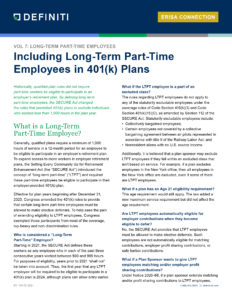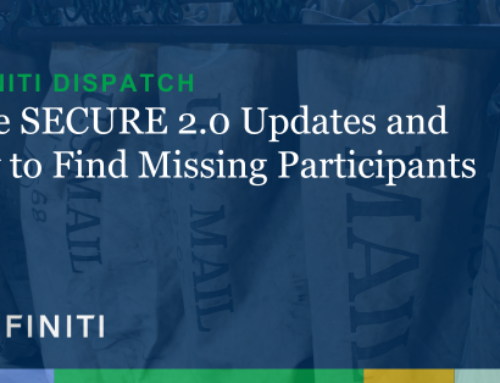On March 29, 2022, the House overwhelmingly passed Securing a Strong Retirement Act of 2022, dubbed SECURE 2.0 because it builds on the SECURE Act from 2019. Although we are still awaiting the final legislation, Definiti expects to see sweeping changes to qualified retirement plans in 2022. These changes include greater incentives for employers to start plans and provisions that improve employees’ retirement savings opportunities.
Here’s an overview of the significant provisions in SECURE 2.0 with our thoughts on what these changes will mean to plan sponsors and the retirement benefits they’re responsible for.
Automatic Enrollment in Retirement Plans
Brand-new 401(k)s and 403(b)s will be required to automatically enroll participants in the plans upon becoming eligible. The initial automatic enrollment amount is at least 3% but no more than 10%. Each year, the amount increases by 1% until it reaches 10%.
Small businesses with 10 or fewer employees, new companies (in existence for less than three years), church plans and governmental plans will all be exempt.
Definiti’s take: Research shows automatic enrollment boosts a retirement plan’s overall participation rate because most employees don’t opt out — and, more importantly, auto-enroll helps more Americans save for retirement. According to a recent Principal Financial Group poll, 84% of workers automatically enrolled in an employer plan said they started to save for retirement sooner than if the plan required them to sign up on their own.
One-year Reduction in Service for Long-Term Part-Time Employees
The SECURE Act provided that employers must allow long-term part-time (LTPT) employees to contribute to the 401(k) plan and defined long-term, part-time employees as employees with at least three consecutive years of service with at least 500 hours of service each year.
SECURE 2.0 would reduce the requirement to two consecutive years of service, allowing some LTPT employees to become eligible as early as January 1, 2023.
Definiti’s take: Many businesses’ livelihoods are reliant on part-time employees. Opening the company retirement plan benefit to more long-term part-time employees sends two messages: We value your contribution to our company and saving for retirement is important.
Treatment of Student Loan Payments as Elective Deferrals
For purposes of matching contributions, an employer will be permitted to make contributions under a 401(k), 403(b), governmental 457(b) or SIMPLE plan for qualified student loan payments.
Because qualified student loan payments will be considered “elective deferrals,” employers can choose to make matching contributions for employees making payments to student loans.
Definiti’s take: Recent news headlines say student loan debt hit a record high of $1.7 trillion. Under the proposed SECURE rule, the roughly 45 million borrowers could receive employer-matching contributions by making eligible student loan payments instead of contributing to their company retirement plan. Being able to pay down college debt while getting company-match dollars is a win-win employees should value.
Changes to Small-Employer Pension Plan Startup Costs
Applicable for tax years beginning after December 31, 2022, the startup credit will increase from 50% to 100%, capped at $5,000 per year, for employers with up to 50 employees. (This is a decrease from the previous 100-employee limit.)
The amount of the credit increases by the applicable percentage of employer contributions on behalf of its employees, up to a per-employee cap of $1,000. Employers with 51–100 employees will receive a phased-out credit.
Additionally, it has been clarified that employers joining a multiple-employer plan or pooled-employer plan in existence for more than three years can take advantage of the credit. This “fix” will be applied retroactively to tax years that begin after December 31, 2019.
Definiti’s take: The larger startup credit amounts should encourage more small businesses to offer a workplace retirement plan, benefiting both the retirement plan sponsor and the company’s employees.
Increased Required Beginning Date for Required Minimum Distributions (RMDs)
Effective for distributions to be made after December 31, 2022, the RMD age will increase to age 73. Starting January 1, 2030, the RMD age increases to age 74. Beginning January 1, 2033, the RMD age increases to age 75.
Definiti’s take: These changes should give retirees more options in managing the tax obligations connected to their hard-earned retirement savings. And having more options is a good thing when it comes to an individual’s choices in retirement.
Increased Catch-up Contribution Limits for Participants Aged 62–64
The current catch-up contribution limit applies to any plan participant who is 50 or older.
For tax years after December 31, 2023, participants who are 62, 63 or 64 will be allowed to contribute up to $10,000 as a catch-up contribution (as indexed for inflation).
Definiti’s take: Catch-up contributions are a great way to help older employees make up for lost time where they either didn’t contribute to a retirement plan or didn’t contribute much. With limits increasing, it makes this feature even more appealing to plan participants who know they should be saving more for their future.
Catch-up Contributions to Be Treated as Roth Contributions
Effective January 1, 2023, all catch-up contributions to qualified retirement plans would be subject to Roth tax treatment.
Definiti’s take: If SECURE 2.0 passes, catch-up contributions from people who are 50 or older will automatically go into a Roth 401(k) account and come from their post-tax salary instead of pretax. While some retirement savers will cheer this news, others will miss the up-front tax savings.
Optional Treatment of Employer-matching Contributions as Roth Contributions
Defined contributions plans may allow participants to receive matching contributions on a Roth basis.
Definiti’s take: Today, employer matching contributions are paid into pretax 401(k) accounts. If SECURE 2.0 passes, retirement sponsors could let employees decide how part or all of the matching contributions get treated tax-wise.
RISE & SHINE Act
On June 14, 2022, the Senate Health, Education, Labor and Pensions (HELP) Committee unanimously approved its version of retirement reform, the Retirement Improvement and Savings Enhancement to Supplement Health Investments for the Nest Egg (RISE & SHINE) Act of 2022. Building off of provisions introduced in the RISE Act and SECURE 2.0, RISE & SHINE contains some key differences.
Additional provisions in RISE & SHINE that are not included in SECURE 2.0 are:
- Allowing the use of plan assets to pay some incidental plan design expenses
- Raising the limit on mandatory cash-out distributions from $5,000 to $7,000
- Including the Emergency Savings Act of 2022, which permits 401(k) plans to allow for emergency savings accounts within the plan. Participants may make pretax contributions to an emergency savings account, and employers may make matching contributions to these accounts. The total amount in the account is not to exceed $2,500, and participants may withdraw amounts at any time as needed.
The Senate Finance Committee passed its retirement reform bill, known as the EARN Act in late June. This bill, combined with the RISE & SHINE Act, is the Senate’s version of SECURE 2.0, and both bills are expected to pass the Senate in the coming months.
We’re Here to Help
Keeping up with new regulations and critical deadlines for retirement plans can be time-consuming if you’re a busy plan sponsor. Definiti hopes to save you time (and stress) by keeping you apprised of the legislative landscape with timely, informative Insights articles and quarterly ERISA Connection updates from our legal team.
If the proposed changes in SECURE 2.0 have you confused about what actions you might need to take when the law changes, we can make things clearer. To start the conversation, call 1-(888)-912-3653 or email sales@definiti-llc.com.
—

Carolyn Cumbee, JD, LLM
ERISA Attorney
Carolyn has more than 18 years of experience working with qualified plans as an ERISA attorney, assisting with the design, implementation and administration of tax-qualified retirement plans, including 401(k), defined benefit, cash balance and 403(b) plans. She frequently advises Definiti’s clients on best practices and methods for correcting many plan document and administrative failures.
—




